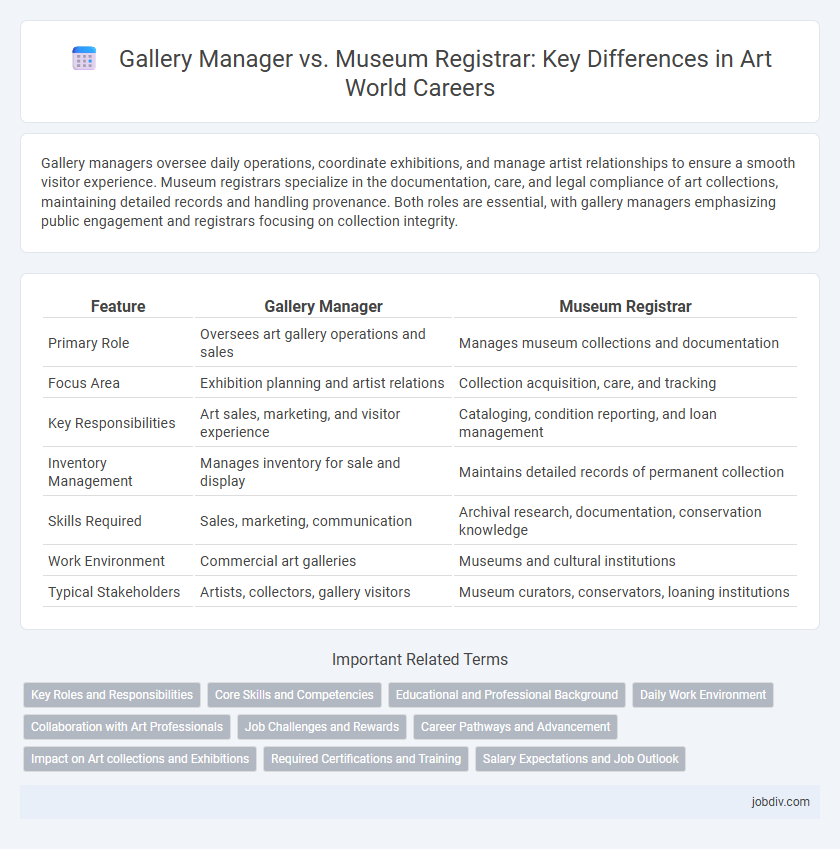Gallery managers oversee daily operations, coordinate exhibitions, and manage artist relationships to ensure a smooth visitor experience. Museum registrars specialize in the documentation, care, and legal compliance of art collections, maintaining detailed records and handling provenance. Both roles are essential, with gallery managers emphasizing public engagement and registrars focusing on collection integrity.
Table of Comparison
| Feature | Gallery Manager | Museum Registrar |
|---|---|---|
| Primary Role | Oversees art gallery operations and sales | Manages museum collections and documentation |
| Focus Area | Exhibition planning and artist relations | Collection acquisition, care, and tracking |
| Key Responsibilities | Art sales, marketing, and visitor experience | Cataloging, condition reporting, and loan management |
| Inventory Management | Manages inventory for sale and display | Maintains detailed records of permanent collection |
| Skills Required | Sales, marketing, communication | Archival research, documentation, conservation knowledge |
| Work Environment | Commercial art galleries | Museums and cultural institutions |
| Typical Stakeholders | Artists, collectors, gallery visitors | Museum curators, conservators, loaning institutions |
Key Roles and Responsibilities
Gallery managers oversee daily operations, coordinate exhibitions, and manage artist relations to ensure successful art presentations. Museum registrars focus on the documentation, care, and movement of artworks, maintaining accurate records and ensuring legal compliance. Both roles are critical in art institutions, with gallery managers emphasizing public engagement and event coordination, while registrars concentrate on preservation and inventory control.
Core Skills and Competencies
Gallery Managers excel in client relations, sales strategies, and exhibition logistics, emphasizing marketing and revenue generation within the art market. Museum Registrars specialize in collection management, documentation, and provenance research, ensuring the preservation and legal compliance of artworks. Both roles require strong organizational skills and a deep knowledge of art history, but Gallery Managers prioritize commercial acumen while Registrars focus on conservation and record-keeping.
Educational and Professional Background
Gallery managers typically hold degrees in art history, business administration, or arts management, with specialized training in curatorial practices, marketing, and sales strategies for art galleries. Museum registrars usually possess advanced education such as a master's degree in museum studies, art history, or cultural heritage, emphasizing collections management, provenance research, and conservation techniques. Professional experience for gallery managers often involves exhibition coordination and client relations, while registrars focus on inventory control, legal compliance, and artifact documentation.
Daily Work Environment
Gallery Managers oversee daily operations including exhibition planning, artist relations, and sales management within commercial or private art galleries. Museum Registrars focus on the care, documentation, and logistics of artwork, managing acquisitions, condition reports, and transportation in public or institutional museums. The gallery environment emphasizes client interaction and market trends, while the registrar's role is more oriented toward preservation and compliance with museum standards.
Collaboration with Art Professionals
Gallery Managers and Museum Registrars collaborate closely with art professionals to ensure the seamless acquisition, documentation, and exhibition of artworks. Gallery Managers coordinate with artists, curators, and marketing teams to promote exhibitions and sales, while Museum Registrars focus on provenance research, condition reporting, and compliance with loan agreements. Their partnership enhances the integrity of art collections and the success of public presentations.
Job Challenges and Rewards
Gallery managers often navigate the challenges of curating diverse exhibitions while ensuring commercial viability, balancing artistic vision with market demands. Museum registrars face complex responsibilities in artwork documentation, condition reporting, and coordinating transportation logistics, requiring meticulous attention to detail. Both roles offer rewards in preserving cultural heritage, fostering public engagement, and contributing to the art world's dynamic ecosystem.
Career Pathways and Advancement
Gallery managers typically advance by gaining expertise in exhibition planning, art sales, and artist relations, often progressing to director roles within commercial galleries or art institutions. Museum registrars build careers through specialization in collections management, provenance research, and conservation coordination, positioning themselves for senior roles like chief registrar or collections manager in museums. Both career pathways require strong organizational skills, art historical knowledge, and networking within the art sector to achieve advancement.
Impact on Art collections and Exhibitions
Gallery managers coordinate art exhibitions, ensuring seamless installation, promotion, and sales, directly influencing public engagement and market value of the collections. Museum registrars maintain detailed records of provenance, condition, and movement of artworks, safeguarding the collection's integrity and supporting long-term preservation. Both roles critically impact art collections by balancing accessibility, security, and historical accuracy in exhibitions.
Required Certifications and Training
Gallery Managers typically require certifications in art management or business administration, with emphasis on courses related to curatorial practices, marketing, and sales strategies. Museum Registrars often hold specialized certifications such as the Certified Registrars Program (CRP) or credentials from the American Alliance of Museums, focusing heavily on collections management, conservation, and legal documentation. Both roles benefit from hands-on training in art handling and database management software, but Museum Registrars demand more rigorous expertise in provenance research and compliance with cultural property laws.
Salary Expectations and Job Outlook
Gallery Managers typically earn between $45,000 and $70,000 annually, depending on location and gallery size, with job growth projected at 6% over the next decade due to increasing art market demand. Museum Registrars command salaries ranging from $50,000 to $80,000, driven by expertise in art handling, documentation, and preservation, with employment opportunities expected to grow by 8%, reflecting the expanding need for cultural resource management. Both roles offer stable career paths, but Museum Registrars benefit from stronger job security tied to institutional funding and collection stewardship.
Gallery Manager vs Museum Registrar Infographic

 jobdiv.com
jobdiv.com